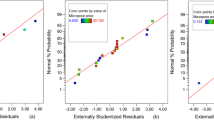Abstract
Synthesis procedure of disordered mesoporous carbon, using commercial silica gel as template, was optimized. The replica method by sucrose/silica gel composite carbonization, followed by silica removal, was used to prepare the mesoporous carbon. Plackett–Burman experimental design allowed the comparison of the individual influence of five parameters on the textural properties and the adsorption capacity of Methylene Blue. All parameters were investigated at two widely spaced levels. Statistical analysis revealed that the sucrose/silica weight ratio and the number of impregnation steps were the variables with major influence in the properties of the as-synthesized carbon. Deeper study, with more levels for the optimization of these variables, was carried out. Mesoporous carbon with large BET surface area (>900 m2/g with ≈10 % of microporous area), narrow pore size distribution and adsorption capacity above 230 mg/g was obtained carrying out the impregnation in only one step and with a sucrose/silica weight ratio of 0.8. The effect of time and temperature carbonization in the properties of the final mesoporous carbon was negligible. However, these variables are important in the reduction of the process cost by saving energy. The lowest values of these variables, which provide a mesoporous carbon with suitable properties and acceptable adsorption capacity, were 600 °C and 15 min.





Similar content being viewed by others
References
C. Liang, Z. Li, S. Dai, Angew. Chem. Int. Ed. 47, 3696 (2008)
T. Kyotani, Carbon 38, 269 (2000)
R. Ryoo, S.H. Joo, S. Jun, J. Phys. Chem. B 103, 37.7743 (1999)
S.H. Joo, S. Jun, R. Ryoo, Microporous Mesoporous Mater. 44–45, 153 (2001)
J.H. Knox, B. Kaur, G.R. Millward, J. Chromatogr. 352, 3 (1986)
A. Fuertes, D.M. Nevskaia, Microporous Mesoporous Mater. 62, 177 (2003)
D.D. Asouhidou, K.S. Triantafyllidis, N.K. Lazaridis, K.A. Matis, S. Kim, T.J. Pinnavaia, Microporous Mesoporous Mater. 117, 257 (2009)
L. Calvillo, R. Moliner, M.J. Lázaro, Mater. Chem. Phys. 118, 249 (2009)
J. Galán, A. Rodríguez, J.M. Gómez, S.J. Allen, G.M. Walker, Chem. Eng. J. 219, 62 (2013)
R.L. Plackett, J.P. Burman, Biometrika 33, 305 (1946)
R.A. Stowe, R.P. Mayer, Ind. Eng. Chem. 58, 36 (1966)
J.M. Gómez, J. Galán, A. Rodríguez, G.M. Walker, J. Environ. Manag. 146, 355 (2014)
N. Kannan, M. Sundaram, Dyes Pigm. 51, 25 (2001)
G. Karaçetin, S. Sivrikaya, M. Imamoğlu, J. Anal. Appl. Pyrolysis 110, 270 (2014)
Acknowledgments
The authors gratefully acknowledge the financial support from Ministerio de Educación y Ciencia by CTQ2008-02728 project, BES–2009–014236 Grant, CONSOLIDER Program through TRAGUA Network CSD2006-44 and Comunidad de Madrid through REMTAVARES Network S- S2009/AMB-1588.
Author information
Authors and Affiliations
Corresponding author
Rights and permissions
About this article
Cite this article
Gómez, J.M., Rodríguez, A., García, J. et al. Synthesis procedure optimization of mesoporous carbon using commercial silica-gel as template for dye adsorption. J Porous Mater 22, 1065–1071 (2015). https://doi.org/10.1007/s10934-015-9981-1
Published:
Issue Date:
DOI: https://doi.org/10.1007/s10934-015-9981-1




